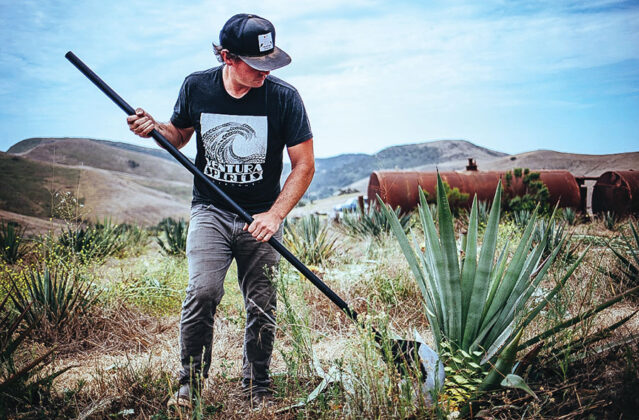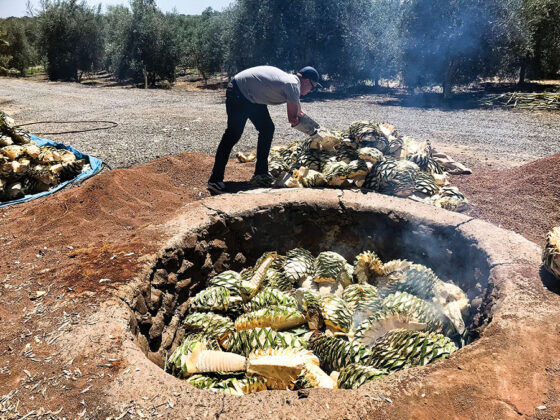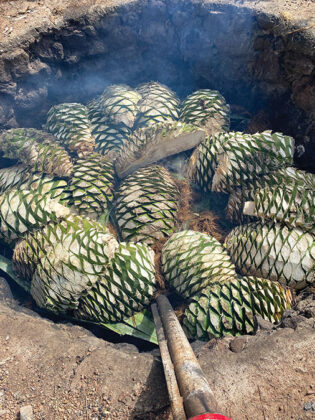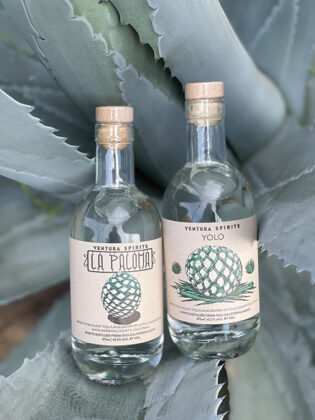With oil derricks pumping near his roll-up door, Henry Tarmy wraps both arms around an overstuffed carton of bottles and hauls its chiming treasures through the length of a 94-year-old lemon-packing plant. Today, the space is a distillery, but back when its boxes were spilling over with fruit, a zesty citrus perfume would drift over the aged floor slabs. It was a fragrance fueled by the same Golden State sun that’s now glaring against the oil derricks, illuminating everything from a spine of scrubby hillsides beyond the distillery door to the high white waves crashing on Ventura Beach six miles away.
There’s no trace of those lost lemon scents now, but Tarmy knows when he uncorks the bottles jingling under his chest other aromas will arise. They’ll have faint hints of honey-pepper wafting off a spirit made from Agave tequilana, grown along hills by the rolling sea. They’ll have a balm of earthy brush fire embers lingering from a liquid made from tequilana cultivated on a western ranch. And they’ll have traces of a floating, toasty sweetness dusting up from the mingling of aged California agave and the wood of ex-rye casks.
At the moment, smells like these can be found at only six distilleries in the most populous state in the union.
When Tarmy founded Ventura Spirits in 2014 with his partners James Greenspun and Andrew and Anthony Caspary, he didn’t necessarily think that his team would end up trailblazing an entirely new movement in American alcohol. But here they are — one of the only distilleries anywhere making genuine California agave spirits and the very first to attempt it in-house with fresh plants.
Ventura’s patrons have already noticed.
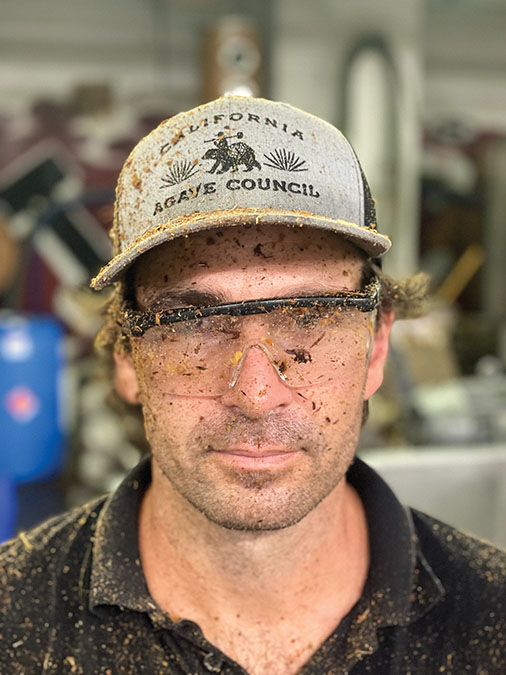
“California is agave crazy as far as tequila and mezcal go, so connoisseurs of that category are definitely interested in something that’s a little bit different,” Tarmy observes. “I don’t see it in a competitive sense. We’re not seeking to replace the rich tradition of what’s coming out of Mexico, but the idea of California as its own little subcategory is fun and interesting, and I think we can make a contribution to the great world of agave spirits.”
A handful of other distilleries are breaking similar ground, with Venus Spirits in Santa Cruz, Shelter Distilling in Mammoth Lakes, and Jano Spirits in Napa County helping lead the way. All have seen enthusiasm from customers, but they’re all facing a shared problem, too: a real California agave spirit means it has agaves grown in California soil — and those are in short supply. So far, the teams have been getting their plants mainly from two men that Tarmy refers to as the state’s north and south agave versions of Johnny Appleseed: Craig Reynolds in Yolo County and Doug Richardson in Santa Barbara County. Reynolds and Richardson have not only gradually developed nurseries, they’ve helped other farmers, ranchers, and landowners plant more, creating agave patches of all sizes (Reynolds even helped his own roofing contractor plant 2,000 agaves on some arid property with only well water).
Reynolds is a retired political operative and the original dreamer behind the California agave trend. It’s a vision that started coming to him around 2006 after working on his own tequila brand for charity in the Mexican states of Colima and Jalisco. Reynolds eventually planted one of California’s first true agave farms on a homestead called the Muller Ranch. Yet, as successful as he and Richardson have been at becoming virtual Johnny Agaves, the fact is the plants take five to eight years to grow to maturity.
“We’re at this point where I think the proof of concept for California agave spirits has been well-established,” Reynolds observes. “At the distillers’ end of things, we don’t have the mature agaves now to meet the demand. That’s going to start improving when people who planted theirs two or three years ago see those agaves start to mature, but there’s going to be a lot of patience required. You can’t make these agaves with a 3D printer.”
Enter Stuart Woolf, one of California’s most prominent tomato farmers. A third-generation grower who took over 30,000 acres from his dad in the San Joaquin Valley, Woolf was curious about how agaves would fare on land that he’d taken out of production due to drought. Agaves can thrive on drip lines, drinking far less water than any of Woolf’s regular crops (they’re dry-farmed in parts of Mexico). These questions started rolling through the ag-master’s mind around the same moment that Reynolds was forming the California Agave Council and getting legislative standards passed for what California agave spirits would be. The two men started talking. In 2020, Woolf planted 1,200 agaves on his farm and then gifted the University of California at Davis $100,000 to study the plant science around them.
Today, Woolf has seen his “experimental plot” bring him 4,000 more plants through agaves re-propagating themselves. The farmer has also made several trips to Ventura Spirits to sample what Tarmy and his crew are making. Woolf likes what he’s tasted. He’s now an apostle for this new frontier for spirits and, at one point, decided to prove it by using his own resources to plant a major, self-sustaining agave nursery that would bring genuine momentum to craft distillers and drought-battered farmers.
Buzz started building from southern California to Napa County that the well-established farmer had a plan underway.
“We’ve had the pleasure of having Stuart in a bunch and talking to him,” Tarmy recalls. “After that, I heard bits and pieces that were like, ‘Stuart’s going big!’”
It wouldn’t be that simple. Woolf was about to go on an odyssey below the border, and his many Homerian challenges would include becoming a victim of an international agriculture heist.
Once Upon a Time in Mexico
Agave seedlings are called hijuelo, which some translate as “off-shoots” and others as “juices.” Whichever image one prefers, Woolf knew that he’d need to produce a lot of these small, sprouting clones to surpass his test plot in a meaningful way. He partnered with an agave exporter in Mexico to get 20,000 plants brought to California from the fields of Zapotlanejo. Woolf followed the progress as these agaves were inspected, purchased, treated, and rinsed for fungicides before getting cleared for the border. All of those services Woolf had paid for in advance. After the trucks were loaded, the big agave convoy started rolling north.
Then, the unexpected happened.
“I was told the load was four hours away from the border crossing, but we needed more money,” Woolf remembers. “When I asked, ‘What do you need more money for?’ I was basically told, ‘Because that’s what it takes to get it over the border.’ You know, they just had me … My load was stolen.”
Despite getting jacked for his agaves, Woolf would not give up. He rolled the dice on another plant migration, but this time he relied on advice and contacts from his own employees in Central California, many of whom have family in Mexico. Woolf eventually traveled to Oaxaca, Michoacán, and Jalisco where he was meeting farmers that he felt comfortable negotiating with. But that doesn’t mean there weren’t hiccups. One would-be dealer toured Woolf through a gorgeous agave field that turned out to belong to a completely different farmer. More common, agave producers showcasing their plants to Woolf seemingly had the edge when it came to haggling. But the American had a secret weapon: One of the farmers that Woolf had befriended had a daughter who spoke good English and took it upon herself to make sure her dad’s compadre wasn’t getting duped or overcharged.
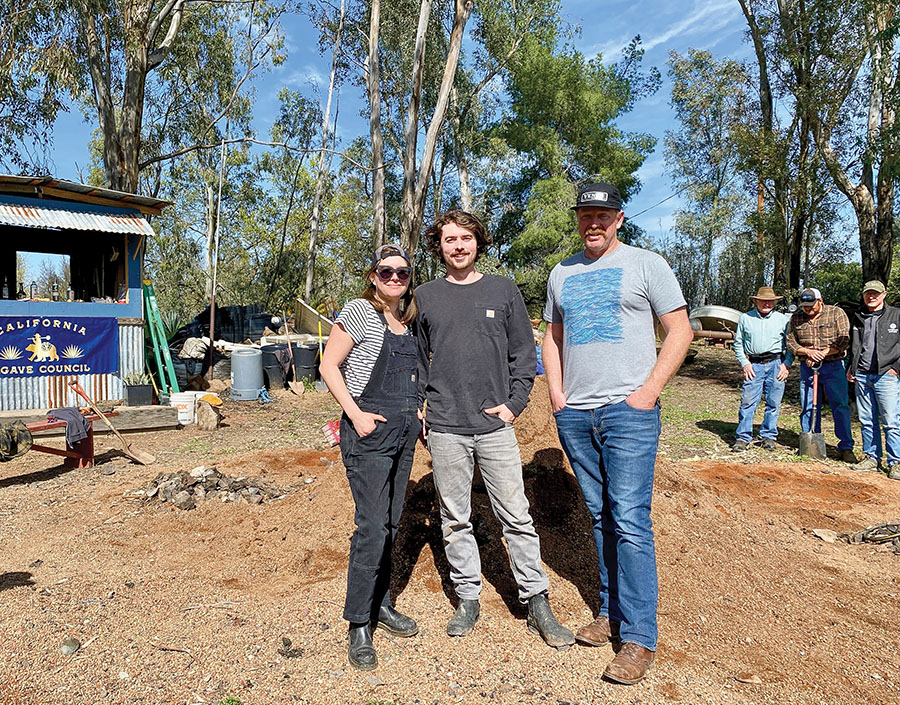
“I lucked out,” he recalls of the daughter’s support. “Honestly, not being from there, and walking into a field and talking about what to pay for these plants and what the terms were, I was at a disadvantage. But when you get a local, headstrong young lady who doesn’t take any stuff from the men, then things start getting done. I don’t think I could have gotten it done without that kind of help.”
Back in California, the help mattered to a number of distillers and farmers on the periphery of agave’s story.
Thanks to how things played out below the border, Woolf was soon planting 210,000 agaves in Fresno County, while selling another 40,000 plants to other growers around the state. For Craig Reynolds, Woolf’s accomplishment was a game changer.
“What Stuart did is the biggest development right now,” Reynolds stresses. “And it was not easy.”
Cruising at California drink speed
A coastal wind whips through the doors of Venus Spirits, energizing its tasting room with an ocean breath that rushes off the filmy afternoon. Shirts are tussling over tequila glasses as casual conversation builds through this half open-air oasis in Santa Cruz’s Westside neighborhood. The mighty distillery this bar is attached to — and the sparklingly new restaurant on the building’s north end — have been fixtures in this central California surfing community only since 2020. But owner Sean Venus has been distilling along the street a lot longer than that, and agave spirits have been part of his repertoire almost since day one.
Venus Spirits originally opened in a smaller commercial space nearby in 2014. Venus was making whiskey and gin, but he decided to experiment with agave spirits derived from special Mexican syrups. This evolved into Venus’s popular El Ladrón line of spirits. Then, in 2021, Venus met Reynolds and learned about Muller Ranch. Venus was keen to see what would happen if he applied his seven years of experience making El Ladrón to working with fresh agaves. Coordinating with Reynolds, he harvested 6,000 pounds of the plant.
Yet Venus would quickly discover what Ventura Spirits was also learning: A distillery that wasn’t designed for processing agave spirits is a distillery that, in fact, needs a lot of on-the-fly modifications.
“None of us are set up with the equipment for roasting or milling agave,” Venus observes. “We’re all taking these kind of crude approaches. Some of us are steaming the agave and roasting them in our mash tuns. Some distillers, like myself, are roasting it in pits. Most of us have created a rough mechanism to shred the agave — a few people are even doing it by hand. At my place, we’ve been using a modified wood-chipper for that.”
Venus adds, “And then there’s going into the fermentation — the fermentation can be a bit tricky.”
The team at Venus used the traditional pit on Muller Ranch to roast their piñas. They decided to light the pit fires with almond wood that was ripped out of a nearby orchard, giving a second life to the sacrificed trees in a manner that influenced the emerging flavor profile. Venus also used the roasted char off the bottom of the batch in his fermentations. The latest vintage he’s preparing to release had a strange roasting process because the pit got filled with water during a freakish storm that was battering California. That meant Venus had to relight the coals and roast longer at a cooler temperature.
Now, as the distiller pours a glass of what came from that wet-ranch chaos, it becomes obvious that nature’s temperament gave birth to fascinating character. The newer vintage tastes more vegetal than the earlier round, a bloom from the almond wood rising up through a more pronounced presence of roasted notes.
“I think it’s a really interesting and remarkable spirit,” Venus says. “There’s a lot of complexity that’s in it, and that is what people are mentioning when they come into our tasting room.”
Tarmy is seeing the same excitement with fans of Ventura Spirits — and he also knows how hard it is for a distillery to make these products in the early stages.
“To start out, we had no oven,” Tarmy recalls. “So, we were downsizing the piñas with a coa tool [a pole-mounted blade used to trim agave] in the distillery once we harvested them, and then we were using the actual kettle of our still as the steam oven. So, we were putting them in there to cook, and then you have this beautiful conversion from white to dark brown — and syrupy sweet — before you pull them out and feed them through a hammer mill, rendering them down to a sort of angel hair pasta-type consistency to the individual fibers, rinse them with hot water, and basically collect the free-run agave juice to use as the basis for the fermentation.”
While a lot of ingenuity was required from the teams at both Ventura and Venus, the distilleries are seeing customer appreciation from the results. And they are not the only ones.
A Spirit of Different Species
Gian Nelson chops his pickaxe into some dirt under a blinding sheen of sunlight. It’s the hottest day of the year on these peaks of the Berryessa Highlands, a brushy line of mountains that rise over California’s Napa Valley. Stepping on a semi-treacherous slope behind his eagle-nested house, Nelson begins planting a small agave into the dry soil. A massive agave is growing a few feet away on the ledge, looking like a spiked and unfurling octopus
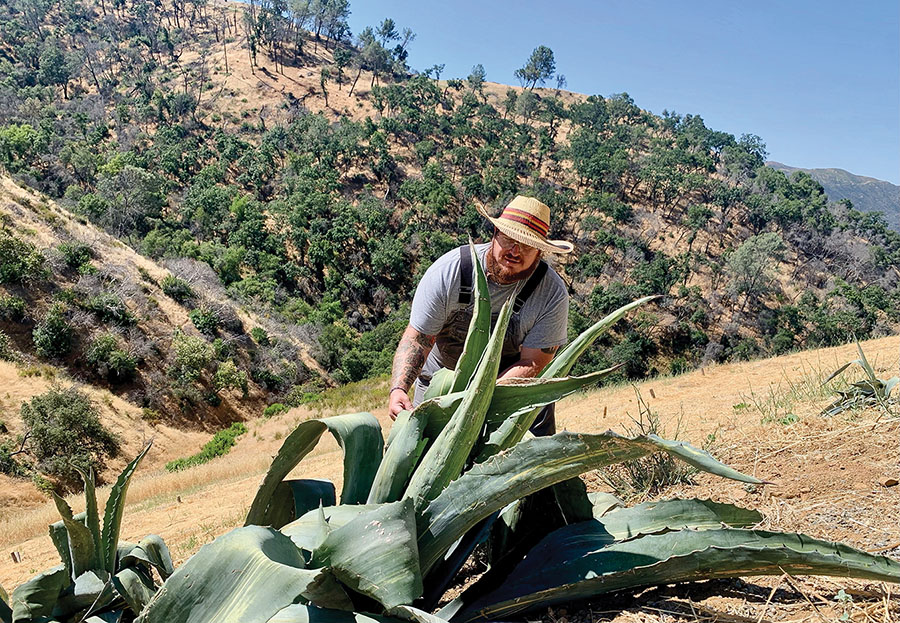
Nelson is agave’s main distiller in the northern half of the state. So far, he’s been building his brand, Jano, entirely on the wild Agave americana: The plant is believed to be the oldest native species of agave in California, growing ubiquitously across valleys, deserts, hill-scapes, and backyards from Red Bluff to San Diego. Nelson is obsessed with learning about what the earliest indigenous tribes did with the americana. And that’s led to him making house calls all over the region.
“I’ll go collect pups from people who call me and want them removed,” he notes. “I’ll go over there and take them off the mother plant — sometimes I take the whole mother plant if they want that ripped out — and then I put them in this nice area here where they can grow bigger … I have about 65 plants so far. I’ve kind of started a side gig where I’m an agave landscaping guy now; and, as I’m building the hillside out here, the agaves are not only great for erosion control, they’re also good for a fire break, since we’ve had some crazy fires out here.”
But this hillside is used for farming experimentation, too. While Nelson’s sloped nursery has plenty of americanas, it’s also allowing him to monitor how tequilana and parryi agaves fare in these unique conditions. So far, he’s observed that the tequilanas are looking stressed from the powerful winds and varying temperatures. They don’t seem to be thriving here. But the parryis are doing well in this climate, and the americanas are proving out their reputation as hardy survivors.
“Jano is focusing on the native varietals of agave, not only because they grow best in their native regions, but because they were the agaves used by the Native Americans here for thousands of years — as far back as the Aztec Empire,” Nelson says. “We want to tell the story of California and its lands in the West through the native species … We also really want to get involved in and support regenerative agriculture.”
Nelson, who’s been distilling in Napa County for seven years, was born in Zihuatanejo, Mexico, before spending his early childhood in the Guerrero region. The essence of the Agave americana that he’s captured with Jano isn’t just connecting him to his heritage, it’s getting the brand attention. Nelson just found out that Jano was awarded a gold medal at the San Francisco Wine and Spirits Competition in its All Other Agave Spirits category, as well as a silver medal from American Distilling Institute’s judging in the U.S. Agave Spirit category.
That’s because Jano tastes like an original, with its swirl of spices on the front and its tumbling cascade of vanilla traces that bloom into a complex, multilayered bouquet of savory touches. The brand has already been welcomed into the bars of numerous restaurants in California’s North Bay, including the Napa Palisades, but Nelson is running into the same basic supply challenge bedeviling his counterparts.
“With Jano, now that we have the recognition, the demand has grown but we can’t make more,” he points out. “We have to be very exclusive and thoughtful about who can carry the product, because we want it to move, but we also want it to move to the right people who believe in it.”
Another nexus between Nelson and the agave pioneers who are south of him is Craig Reynolds’ Muller Ranch. The team at Ventura Spirits takes tequilana agaves grown there and steam-roasts them at their own facility, while Nelson takes Agave americanas that are not grown on that property and uses the ranch’s pit for roasting, while Venus takes Muller tequilanas and also roasts them on the grounds where they were cultivated. Under Reynolds’ steady hand, a sense of cooperation is allowing all of the different players to learn together about what works and what doesn’t with different agave species and roasting techniques.
Tarmy says the dialogue and mutual aid is vital to developing a market. So far, Ventura Spirits is one of two distilleries that’s making, bottling, and selling agave vintages from both the tequilana and americana species (the other being Shelter Distillery). This too is part of the learning curve.
“For me, there’s an enormous difference between our tequilana spirits and the americana spirits that we’ve made,” Tarmy acknowledges. “The americana has this strong pepper note that hits you first thing, and it’s almost spicy with some notes of smoke in it.”
While Ventura’s tequilana vintages have calmer flavor profiles, they also don’t taste like each other, depending on whether the plants came from Muller Ranch in the north or La Paloma Ranch in the south.
“It’s really interesting to see,” Tarmy stresses. “Same species. Same distillery. Same basic process. There’s taste variations between them — there’s a difference.”
Ventura Spirits co-founder Andrew Caspary breaks it down even more specifically.
“I usually talk with customers about the tasting notes being more vegetal, more green, and more plant-forward in the La Paloma spirit,” Caspary says. “You just get more traditional baking spice. Whereas the Yolo agave spirit [from Muller Ranch] would be more familiar as a slightly cleaner blanco tequila-type of spirit.”
From the Pacific Coast Highway to the vineyards of Napa Valley, the findings and fine-tuning around California agave spirits continue; and with each vintage hitting the tasting rooms, the collective belief in a new movement grows.
“It’s a pretty dynamic process and we put a lot of effort and time into it — a lot of time,” Venus emphasizes. “But, as a distiller, it has been great to be there all the way from when the piñas are harvested to the point where we can actually taste it on our lips. To be involved in that entire process is pretty remarkable.”

